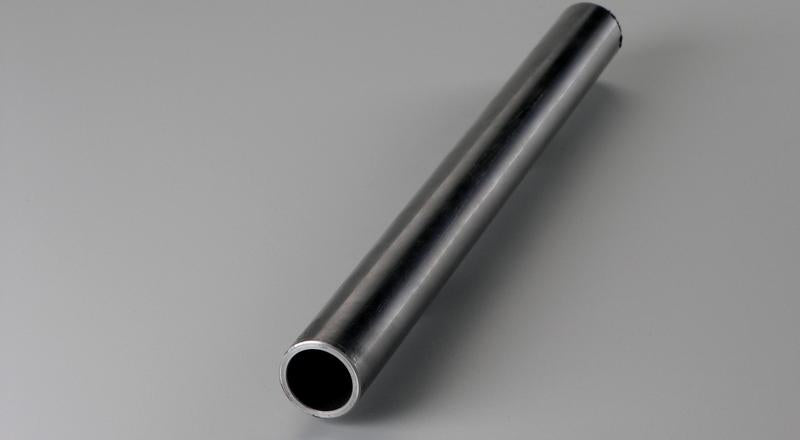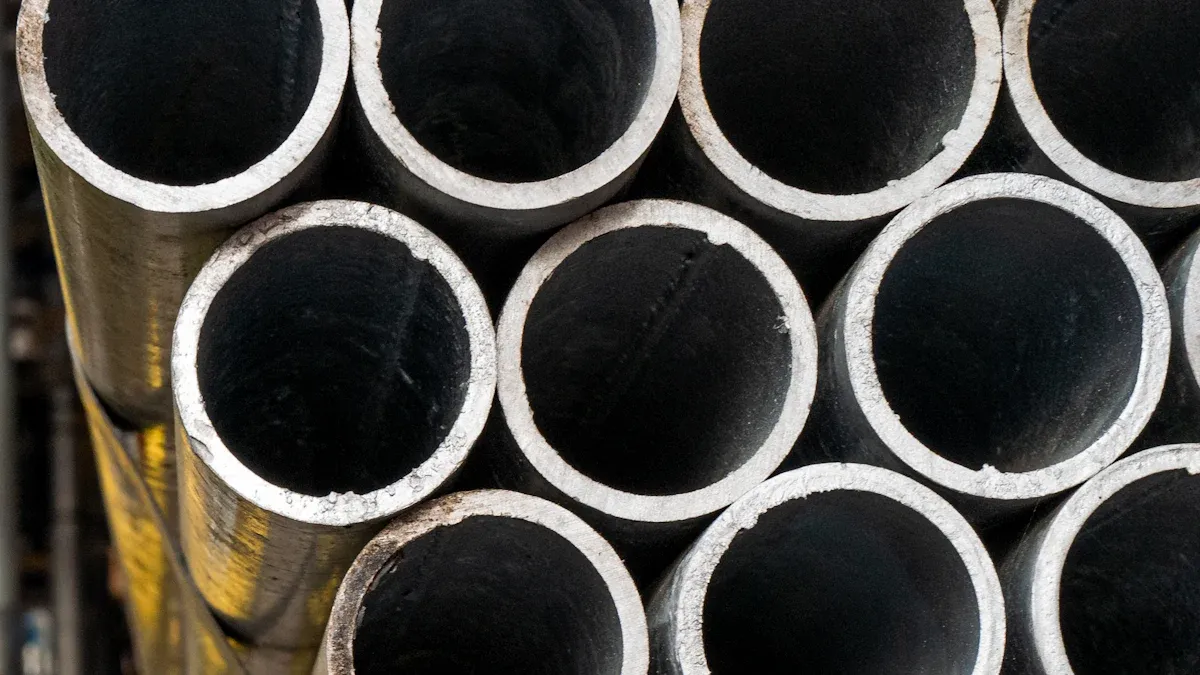
How to Choose the Right Steel Round Tube for Your Project in 2025
Share
Table Of Content
Table Of Content
Choosing the right steel round tube for your project in 2025 starts with knowing its use. Industries like building, cars, and energy need these tubes for strength and rust resistance. For example, oil demand worldwide may grow by 1.1 million barrels daily, increasing the need for strong pipelines. Also, more refining in Asia-Pacific and the Middle East shows why materials like the 4130 Chromoly Round Tube are important. Whether you need an Electric Welded (ERW) Round Steel Tube or a Drawn Over Mandrel (DOM) Steel Round Tube, picking the right one helps your project succeed easily.
Key Takeaways
- Think about what your project needs to pick the right steel tube. Look at strength, rust protection, and how it will be used.
- Learn the difference between seamless and welded tubes. Seamless tubes are stronger and good for high-pressure work. Welded tubes cost less and work well for everyday jobs.
- Think about how much materials will cost over time. Stainless steel costs more at first but saves money on fixes later.
- Make sure the steel tubes meet industry rules and standards. This helps keep your project safe and high-quality.
- Plan for future changes in the steel industry. Green materials and new tech can make your project better and more eco-friendly.
Types of Steel Round Tubes

Seamless Steel Round Tubes
Seamless steel tubes have no welds or joints. They are made by heating solid steel and piercing it into a hollow shape. This process creates smooth, even tubes. These tubes work well in high-pressure jobs. Industries like oil and gas use them for their strength and dependability. They also resist breaking under stress, making them great for hydraulic systems and heavy machines.
Welded Steel Round Tubes
Welded steel tubes are made by rolling flat steel into a cylinder. The edges are welded together to form the tube. This method is cheaper and good for making many tubes quickly. Electric Welded (ERW) tubes have carbon, iron, and manganese in them. They are strong, with a tensile strength of 132,000 psi and a yield strength of 74,185 psi. Welded tubes are very popular, making up 70.5% of the market in 2024. They are used in buildings, car parts, and engineering projects. Better welding technology has made these tubes stronger and more reliable.
Galvanized Steel Round Tubes
Galvanized steel tubes have a zinc coating to stop rust. This layer protects them from moisture and makes them last longer. These tubes are great for outdoor projects like fences, handrails, or water pipes. The zinc coating saves money on repairs and keeps the tubes in good shape. If you need strong, rust-proof tubes, galvanized ones are a smart choice.
Stainless Steel Round Tubes
Stainless steel tubes are strong and resist rust very well. They have chromium, which creates a shield to stop rust. These tubes work great in wet or tough places. Examples include boats, chemical plants, or food equipment.
You should check the grade when picking stainless steel. For instance, Stainless Steel 304 resists rust better than 201. It lasts 50%-100% longer in wet areas because it has more chromium and nickel. This makes it a smarter choice for long-lasting projects. While 304 costs more at first, it saves money later. Fixing 201 can cost $150-$500 yearly per square meter, but 304 needs fewer repairs, cutting costs.
Stainless steel tubes are also strong and look nice. Their shiny finish is perfect for buildings, railings, and decorations. Plus, they can be recycled, making them a green choice for your project.
Mild Steel Round Tubes
Mild steel tubes are cheap and useful for many projects. They are made from low-carbon steel, making them easy to weld and shape. Use them for building, furniture, or car parts.
A big benefit of mild steel is its low price. It costs less than stainless steel, so it’s good for saving money. But mild steel rusts easily, so don’t use it in wet or harsh places. Adding paint or powder can help it last longer.
Mild steel tubes are light but strong, so they’re easy to move and install. You can cut, bend, or shape them to fit your needs. If you want a strong and affordable material, mild steel tubes are a good pick.
Key Factors to Think About When Picking a Steel Round Tube
Rust Resistance
Rust can make steel tubes weaker over time. This happens more in wet or chemical-filled places. Pick a material that fits your project’s needs. For outdoor or sea use, stainless or galvanized steel tubes work well. Stainless steel has chromium, which stops rust. Galvanized steel has a zinc layer that keeps moisture away.
If your project faces strong chemicals, use stainless steel like grade 316. It fights rust better. These may cost more at first but save money later. They need less fixing and last longer.
Strength and Toughness
A steel tube’s strength depends on its type and build. Seamless steel tubes are great for tough jobs because they are even and strong. Concrete-filled steel tube (CFST) columns are another strong choice. They mix steel and concrete for better fire safety and flexibility.
Here are some cool facts about CFST columns:
- They resist fire for over 240 minutes in some cases.
- Multi-chamber designs handle energy and pressure better.
- New materials like recycled parts and aluminum help the environment.
| Study Area | Main Discoveries |
|---|---|
| Predictive Modeling | Showed how tubes perform under heavy loads. |
| Energy Handling | Multi-chamber designs improve energy and pressure control. |
| New Materials | Recycled parts and aluminum are strong and eco-friendly. |
Price and Budget
Your budget matters when picking steel tubes. Mild steel tubes are cheap and good for tight budgets. But they might need coatings to stop rust, which costs extra.
Market changes also affect prices. The steel tube market is growing, which could raise costs. Plan your budget carefully to avoid surprises.
| Evidence Type | Details |
|---|---|
| Market Growth Trends | Shows how the steel tube market is growing, helping with budget plans. |
| Price Studies | Gives clear details on costs for better planning. |
| Money Needs | Explains how much money is needed for projects, helping with financial decisions. |
By balancing price, strength, and durability, you can pick the best tube for your project.
Application-Specific Needs
Each project has different needs. Picking the right steel tube depends on how it will be used. For example, construction tubes must hold heavy weight. Plumbing tubes need to resist rust. First, figure out what your project needs. Will the tube face high pressure, heat, or chemicals? Seamless tubes are great for hydraulic systems. Galvanized tubes are best for outdoor use.
Think about what your industry requires. Car makers like mild steel because it’s light and strong. Food and medical tools use stainless steel since it’s clean and safe. Matching the tube to your project keeps it safe and long-lasting.
Also, check the tube’s size. Wall thickness and diameter change strength and weight. Thicker walls are stronger but heavier. This might not work for planes or cars. Always ask suppliers or engineers to make sure the tube fits your needs.
Environmental and Future Needs
Picking eco-friendly materials is important now. Recycled steel tubes help the planet. Using 100% recycled steel can cut carbon by 60%. This makes it a smart choice for green projects.
Think about the future when planning. The steel industry uses new tech like smart modeling to improve tubes. Research shows recycled materials and new designs help the environment. Multi-chamber CFST columns are one example. They are stronger and better for green building.
| Study Name | Main Ideas |
|---|---|
| Steel Tubes Market Size, Growth, Trends, Report 2032 | Recycled steel lowers carbon and saves resources. |
| Reuse of Steel in Construction: Challenges and Opportunities | Reused steel cuts carbon by 60%. |
| Advanced Machine Learning for CFST Columns | Shows better strength and eco-friendly benefits. |
By choosing green materials and learning about new ideas, you can make your project last longer and help the planet.
Comparing Steel Round Tube Materials

Stainless Steel vs. Mild Steel
When picking between stainless steel and mild steel, think about strength and price. Stainless steel resists rust well because it has chromium. It works great in wet or tough places like boats, food factories, or hospitals. Mild steel costs less and is easy to shape or weld. It’s best for indoor projects or dry areas.
Stainless steel lasts longer and needs fewer repairs, saving money later. Mild steel might need paint or coatings to stop rust, which adds cost. If you need strong and long-lasting material, pick stainless steel. For cheaper options, mild steel is a good choice.
Galvanized Steel vs. Non-Galvanized Steel
Galvanized steel has a zinc layer that stops rust. This makes it perfect for outdoor jobs like fences, rails, or water pipes. Non-galvanized steel doesn’t have this layer, so it rusts faster in wet or salty places.
Tip: Hot-dip galvanizing makes a strong coating that lasts longer. It protects better than just painting the steel.
| Material Type | Lifespan Estimation | Corrosion Behavior in Marine Environment |
|---|---|---|
| Galvanized Steel | Shorter lifespan | Moderate corrosion resistance |
| Stainless Steel | Longer lifespan | High corrosion resistance |
If your project faces water or chemicals, galvanized steel is a smart pick. For places needing more rust protection, stainless steel works better.
Seamless vs. Welded Steel Round Tubes
Seamless steel tubes are made without welds, making them very strong. They handle high pressure well, so they’re great for pipelines or hydraulic systems. Welded tubes are made by joining flat steel edges. They cost less and come in longer sizes.
Seamless tubes are best for thick walls and tough jobs. Welded tubes work well for big sizes with thinner walls. For hard conditions, seamless tubes are the best choice. For easier jobs, welded tubes save money.
Wall Thickness and Weight Considerations
The wall thickness of steel round tubes affects their strength and weight. Thicker walls make tubes stronger and able to hold more weight. But, they also make the tubes heavier, which can make moving and installing them harder. You should choose the right thickness based on your project’s needs.
For example, thinner walls work well for light items like furniture or decorations. Thicker walls are better for strong systems like columns or pipes. The table below shows how wall thickness changes the weight of steel tubes:
| Outer Diameter | Wall Thickness | Length | Weight (lb/ft) |
|---|---|---|---|
| 3/8" | .065" | 240.00" | 0.215 |
| 1/2" | .049" | 240.00" | 0.236 |
| 1/2" | .065" | 240.00" | 0.302 |
| 5/8" | .083" | 240.00" | 0.480 |
| 3/4" | .120" | 240.00" | 0.807 |
| 1" | .109" | 240.00" | 1.037 |
This table shows how small changes in thickness affect weight. For instance, a 1-inch tube with .109" walls weighs 1.037 lb/ft. The same tube with .065" walls weighs only 0.649 lb/ft.
Tip: Think about the balance between weight and strength when choosing tubes. Heavier tubes are stronger but cost more to move and install.
Studies show thicker walls improve how much weight tubes can hold. Engineers use this data to design safer and better structures.

Also, think about how weight affects the environment. Heavier tubes need more energy to move, which increases pollution. Picking the right thickness helps your project and the planet.
By learning how wall thickness and weight connect, you can make smart choices. Always ask suppliers or engineers to check if the tube fits your project.
Practical Tips for Picking the Right Steel Round Tube
Talk to Experts or Suppliers
Ask experts or suppliers for help when choosing steel tubes. They know how different types work for specific projects. Their advice can help you pick the best tube for your needs.
For example:
- Experts explain seamless and welded tubes for high-pressure jobs.
- They suggest galvanized or stainless steel for outdoor use.
- Their tips match your project’s needs and budget.
Talking to professionals lowers mistakes and ensures you use the right materials.
Think About Long-Term Needs
Plan for how your project will last over time. Will the tube face bad weather, heavy weight, or chemicals? Picking the wrong tube can cost more later.
For outdoor use, galvanized steel stops rust well. For high-pressure jobs, seamless tubes are very strong. For food or medical tools, stainless steel is clean and durable.
Also, think about future trends. Recycled steel and new designs are eco-friendly. Planning for these can save money and help the planet.
Check Standards and Certifications
Make sure the steel tube meets industry rules and certifications. These prove the material is safe and high-quality. Look for labels like ASTM or ISO to ensure global standards.
Certified tubes lower risks and make projects more reliable. They also make it easier to work with suppliers and builders.
Tip: Ask suppliers for proof of certifications. This ensures the tube fits your project’s needs.
Test Samples for Quality Assurance
Testing steel round tubes checks if they meet quality rules. It helps find problems before using them in big projects. Tests often check strength, durability, and size accuracy.
Math tools measure how good the tests are. For example, numbers like RMSE and R2 close to 1 show high accuracy. The table below shows key testing results:
| Metric | Value |
|---|---|
| RMSE | Close to 1 |
| R2 | Close to 1 |
| MAPE | Small difference |
| Error Ratio (E.R.) ≤ 5% | Most predictions |
| E.R. between 5% and 10% | 4% of predictions |
| E.R. > 10% | 1% of predictions |
| CoV of ultimate strengths | 0.04 |
| Correlation of actual and projected strengths | Strong match |
These results prove most steel tubes work well, with few issues. Testing also checks if tubes handle tough conditions like high pressure or heat. Always ask suppliers for test reports to confirm quality.
Tip: Test a few samples first to save money and avoid mistakes. This ensures the steel tube fits your project’s needs.
Plan for Future Trends in Steel Round Tubes for 2025
The steel tube market is growing fast due to new tech and demand. In 2024, it was worth USD 83.35 billion. By 2033, it may reach USD 93.25 billion, growing 1.24% yearly from 2025 to 2033. This growth comes from industries like building, cars, and energy.
New technology is improving steel tubes. Seamless tube making and electric welding make stronger, rust-proof tubes. These are great for planes and oil pipelines.
Energy needs also affect the market. Oil use may rise by 1.1 million barrels daily in 2025, reaching 103.9 mb/d. This means more strong pipelines are needed. U.S. factories grew by 1.2% in late 2024, showing a strong market for steel.
Think about how these trends affect your project. Choose eco-friendly or high-quality steel tubes for future needs. Planning ahead keeps your project useful and sustainable.
Knowing about the types and features of steel round tubes helps you choose wisely. Each type has special advantages, like stainless steel resisting rust or mild steel being budget-friendly. Important things to think about include rust resistance, strength, and price. For instance, stainless steel is great for tough conditions, while galvanized steel works best outdoors.
Tip: Talk to experts to find the right tube for your project. Thinking about future needs helps your project last longer.
| Category | Key Points |
|---|---|
| Outside Conditions | Rules, costs, and location benefits affect industry success. |
| Cost Planning | Knowing prices and profits helps you manage your budget well. |
| Performance | Sales trends and market changes show why strong materials matter. |
| Products and Markets | New ideas and trade changes affect what materials are available. |
| Regional Factors | Local benefits change how you get materials and plan projects. |
By keeping these points in mind and asking experts, you can pick the best steel round tube for your needs.
FAQ
What makes seamless and welded steel round tubes different?
Seamless tubes are made without welds, so they are stronger. They work well for high-pressure tasks. Welded tubes are made by joining steel edges. They cost less and are good for general projects.
Tip: Use seamless tubes for tough jobs and welded ones to save money.
How do I pick the right wall thickness for my project?
Thicker walls are stronger but make the tube heavier. For light projects like furniture, thinner walls are better. For heavy-duty or high-pressure jobs, choose thicker walls.
Note: Ask engineers to check if the wall thickness fits your needs.
Are galvanized steel tubes good for marine areas?
Galvanized steel has a zinc layer that stops rust. It works well outdoors. But in salty places, stainless steel lasts longer and resists rust better.
Emoji Reminder: 🌊 Pick stainless steel for long-lasting use near the ocean.
Can steel round tubes be recycled after use?
Yes, steel tubes can be recycled. Recycling steel cuts carbon emissions by up to 60%. This makes it a great choice for eco-friendly projects.
How can I check the quality of steel round tubes?
Ask suppliers for certifications like ASTM or ISO. Test samples to check strength, durability, and size before buying.
Pro Tip: Always check quality to avoid problems and extra costs later.
